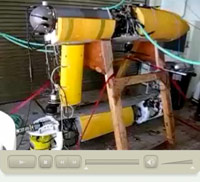|
  Today's Weather Sun, scattered clouds Lat: 04° 34’S Long: 21° 47’W Air Temp: 78.0°F Bar Pressure: 1011.0 mbar Sea Temp: 80.0°F Sea State: 5 to 7 ft Swell Height: less than 7 ft, SE Wind: SSE; 11 to 16 knots Visibility: Unlimited
January 3, 2008 (posted January 4, 2008) by Susan Humphris, edited by Kristen Kusek In the hangar on the after deck (rear deck), the robotic underwater vehicle Jaguar has been happily running now for more than a day and a half. But its sibling autonomous underwater vehicle (AUV), Puma, has not been so well behaved. During the night, one part of its electronic “brain” stopped talking to another part. As a result, the AUV wasn’t doing what it’s supposed to do, which is to send out information. Here is what is supposed to happen. An internal board forming part of Puma’s “brain” sends out a very accurate time pulse each second. (Keep in mind that all clocks drift a little bit. Some are a bit fast, and some are a bit slow.) This time signal, which is set using Global Positioning System satellites when the AUV is on deck, is so accurate that it drifts only 1 thousandth of a second every 14 hours—equivalent to about 1 second every 20 months! When the acoustic modem in Puma’s “brain” hears the time pulse, it sends out a packet of information, in the form of sound signals, to the ship. However, although both components were working separately, they were not “talking” to each other, explained Sarah Webster, a graduate student from Johns Hopkins University. Off came Puma’s main electronic housing, and back into the lab it went. Graduate students performed a kind of surgery; they opened it up, checked connectors, and put everything back together again. By late morning, we had two AUVs happily chirping away in the hangar—sounding more like birds than “cats”! Early this afternoon, the research vessel Knorr came to a stop for the first time since we left Natal on Monday. Our work began with a lowering of the CTD As we lowered the CTD close to the ocean bottom, engineers sent a sound signal to the transponders to start them pinging, and then the engineers listened. They could hear them loud and clear. Some celebrated this happy event with peanut butter cupcakes. Late in the evening, we were ready to dunk a cat. This time, Jaguar’s electronics were on the lab bench so that the computer that runs Jaguar’s cameras could be installed. But Puma was raring to go! Engineers have to test how well each AUV is ballasted, or weighted properly so that it either sinks or floats in seawater. “You want the AUV slightly positively buoyant so that it will float to the surface if something goes wrong,” explained graduate student Clay Kunz. “But you also want its nose to point slightly down to help it descend to the bottom.” Tonight engineers lowered Puma on a tether (a strong line) over the ship’s stern. It took two dunks and a little extra weight to get the ballast right. Then a dripping robotic cat was put back in the hangar, and Knorr headed off into the black, starry night to the Mid-Atlantic Ridge [ Previous day ] [ Next day ]
|
||
Mailing List | Feedback | Glossary | For Teachers | About Us | Contact
© 2010 Dive and Discover™. Dive and Discover™ is a registered trademark of Woods
Hole Oceanographic Institution



